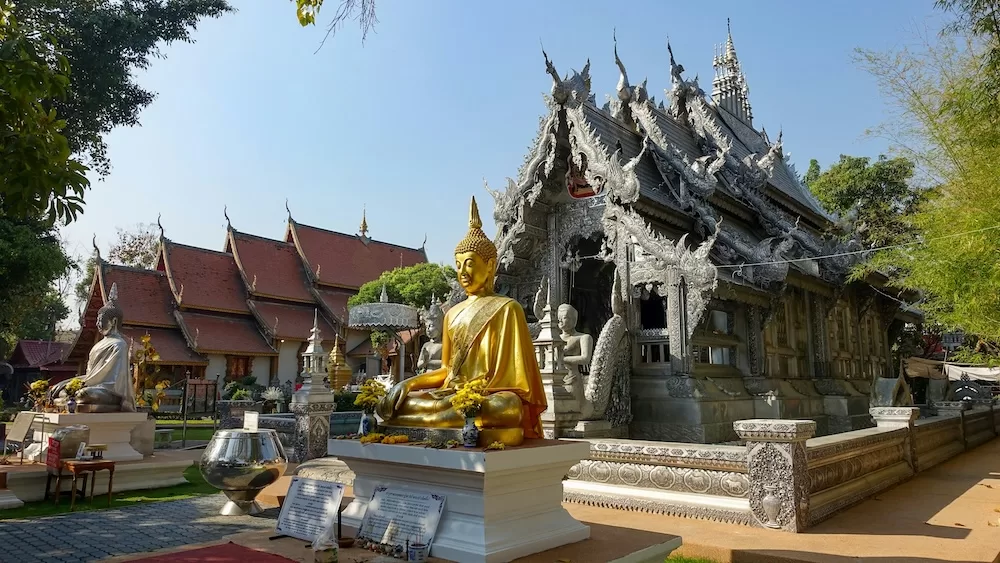
2 Week Vietnam Itinerary – From North To South
15-day Itinerary – Travelling North to South Vietnam
We are travel enthusiasts and love travelling to different places and exploring the uniqueness of each country we visit. During our trip to Southeast Asia, we visited Vietnam starting off our trip in Hanoi with our daughter … what an assault on the senses! Our flight to Vietnam from Australia was long and as soon as we landed at the Noi Bai International Airport, we headed straight to our hotel. We had a power nap there before starting the adventure.
In this article, we will be sharing our detailed itinerary for a jam-packed 2-week itinerary from North to South Vietnam.
Vietnam: Best Places to Visit
- 15-day Itinerary – Travelling North to South Vietnam
- Hanoi The Capital – Days 1 to 4
- Trekking In Sapa – Days 4 to 6
- Ha Long Bay Cruise – Days 6 to 8
- Ninh Binh – An Ancient Province
- Hoi an – The Bright City – Days 10 to 12
- What to do in Hoi An
- Relaxing On The Beach In Nha Trang – Days 12 to 13
- What to do in Nha Trang
- Ho Chi Minh City – The Final Stop – Days 13 to 15
- Things to do in Ho Chi Minh
- Where To Stay In Ho Chi Minh
- Important Travel Tips For Vietnam
- Essential Travel Toolkit
Hanoi The Capital – Days 1 to 4

Starting in the north, we landed at the capital of Vietnam, Hanoi. For our travelling from and within the cities, we used all modes of land-based travel – scooters, buses and trains. We booked our tickets online – see 12Go – they give you all options for internal travel from your destination to the next. Travelling this way allowed us to experience Vietnam in a way you wouldn’t if you flew from city to city. It is cheap and doable to fly internally in Vietnam, but if you want to travel across Vietnam and enjoy the adventure, culture and crazy, you should go on sleeper buses, sleeper trains and scooters.
In Hanoi, we felt most in Vietnam as we got to see Vietnamese culture in every corner of the city. From a variety of their dishes to their cultural dresses, it was quite amazing getting to witness their culture and traditions. Some of the main sites we visited were – the famous train street, the Old Quarter, and we tried as many new foods as we could. We had the best experience on a food tour! We cannot recommend this enough if you want to try authentic Vietnamese food. You can learn more about the top things to do in Hanoi in our Top 10 Things To Do In Hanoi Post. We stayed there for three days and then made our way to the Sapa mountains.
Best Place To Stay In Hanoi
The best area to stay in Hanoi is the Old Quarter, its central position allows for easy access to the most iconic landmarks such as Hoan Kiem Lake, Dong Xuan Market, Hang Da Market, Hang Bac Street, and Hang Gai Street.


The French Quarter is another area to stay, however, there are fewer budget accommodations but many of the city’s sights are located in the French Quarter. as is much of its historic architecture.
Trekking In Sapa – Days 4 to 6
Nestled at the top of a deep valley, Sapa town is surrounded by stunning rice terraces that have been cultivated in the same way for centuries. The scenery here is simply spectacular. Winding roads lead down to the valley floor, where white-water rivers weave through the rice fields, and lush green mountains stretch endlessly into the distance. Overlooking it all is Mount Fansipan, the highest peak in the region, towering above the rugged ridge line. Expect crowds, as Sapa is a popular destination for backpackers and trekkers alike. What makes Sapa truly special is its empowerment of local women. Traditionally, women in the H’mong hill tribe were homemakers, but tourism has changed that. Today, women are guides and shopkeepers, breaking traditional roles and gaining a stronger voice in their community.

The top activity and draw of Sapa is trekking. You can opt for day treks across rice paddies, or one of the best ways to go trekking around Sapa is on a guided tour to Mount Fansipan. Depending on where you trek, these tours take you through breathtaking rice paddies and allow you to experience real Sapa away from the tourists and crowds. You will be able to visit ethnic minority villages in Sapa, and immerse yourself in the reality and struggle that some of these villages have had to face and endure. Whatever trek you choose, your guides will be able to take you through the beautiful rice terraces and to some of the most picturesque spots. You will be given plenty of opportunities to interact with the local villagers and learn about their way of life.
The Sapa trek is highly recommended as Mount Fansipan is an unforgettable trekking experience. Mt Fansipan – referred to as the roof of Indochina – is not just the highest peak in Vietnam at over 10,000 feet, but also in the whole Indo-Chinese Peninsula which includes Laos and Cambodia! Therefore it is a must-visit!
After our 2-day hike, we left for Halong Bay. The route from Sapa to Halong Bay is around 7-8 hours long but we first took a train to Hanoi in the evening, stayed in a hotel, and then had a transfer to Ha Long Bay with our cruise booking. You can travel from Sapa to Ha Long all in one go on a bus, but that’s a full 9-hour trip on a bus. It was much nicer breaking the journey up, and giving ourselves a proper rest.
Best Place to Stay in Sapa
There are plenty of options available when it comes to finding a place to stay while visiting Sapa. You can find anything from luxurious villas perched high in the mountains to cosy homestays nestled within local villages – There’s something for everyone, no matter what kind of experience you’re looking for.
Sapa town has easy access to amenities and boasts a vibrant atmosphere and nightlife. It is because of the latter that Sapa town is getting busier and busier year after year. It is a backpacker’s mecca and has the bars and tourist shops to match. Additionally, most tour companies collect guests from the centre of town, it’s a good central area to stay if you need to get an early start or you’re arriving back late in the evening and don’t want to commute to a village. Sapa town is also where you’ll find all the restaurants and bars.

Lao Cai Province has it all – Village homestays, luxury resorts and eco-lodges perched high on hills and tucked away in low valleys. Making this the best place to stay if you are wanting to get out of Sapa Town and experience local culture and customs, as well as relax in peace and harmony.
Ha Long Bay Cruise – Days 6 to 8
Spanning 65,650 hectares and encompassing 1,133 islands and islets, Ha Long Bay – Cat Ba Archipelago is located in Northeast Vietnam, within Quang Ninh Province and Hai Phong City. This stunning seascape features a multitude of limestone islands and islets emerging from the sea in various sizes and shapes, showcasing picturesque, unspoiled nature. Ha Long Bay – Cat Ba Archipelago is truly a masterpiece sculpted by nature.
For many, Ha Long Bay’s seascape is the quintessential image of Vietnam. Cruises navigate the emerald green waters, weaving among thousands of rugged islands and islets, and stopping at spectacular caves where tourists explore impressive, centuries-old formations. Ha Long Bay’s mystical beauty has earned it a spot on many travellers’ bucket lists, yet there are still secluded corners where you can find your slice of paradise.

We had booked a 3-day 5-star cruise at Halong Bay. The price ranges depending on how long and how luxurious the cruise is. Our booking came with a transfer from Hanoi to Ha Long Bay, this was an extra fee on top of the cruise price, but well worth it because it was far better than travelling on a bus. It was a beautiful experience and a welcome rest after our trek in Sapa. Subject to the cruise you book depends on the activities that you have onboard your cruise. All entrance fees to our activities were included in the price, additionally, a kayak through different caves and a cycle through Viet Hai Village. We suggest you read the reviews for as many of the cruises as you can before you book. The prices vary and it’s worth making sure that you get as many all-inclusive options as possible for the price. Remember, just because it’s expensive doesn’t mean it’s worth the price. We booked ours through Get Your Guide, they have an array of cruisers that differ in time and price
Ninh Binh – An Ancient Province
Far too few travellers venture to Ninh Binh, a captivating region often referred to as ‘Ha Long Bay on Land’ due to its enchanting riverine landscape, where sheer limestone mountains rise from the paddies. The best way to experience this UNESCO-protected site is by taking a paddleboat tour along its shimmering rivers and climbing to the top of its legendary peaks.
When visiting Ninh Binh Province, most people stay in the main towns of Trang An and Tam Coc. The landscape is staggering, with karst mountains, vivid green valleys and meandering rivers. This area may look familiar – it is where the film Kong: Skull Island was filmed – something Ninh Binh is now well known for.

The bus ride to Ninh Binh from Halong Bay took approximately 4 hours to reach the Ninh Binh province. We decided that it would be better and wiser if we took a rest for the day and began our journey the next day. So as soon as we reached Ninh Binh, we checked in our hotel rooms and slept like a top! We stayed in Ninh Binh for 2 nights and 3 days. One tough decision for us was to decide the best place to stay in this vast province.
Best Place To Stay In Ninh Binh

Most travellers that travel to Ninh Binh Province do not stay in Ninh Binh City as it is quite congested and not a pretty place to stay. They tend to head to Tam Coc or Trang An. Generally, Tam Coc is full of backpackers and closer to all the attractions. It’s mostly centred on your typical backpacker or tourist street and travelling around, you’ll see many places just like it. Since Tam Coc is also where most day-trippers go, at certain hours it’s filled with tour buses. However, if you are willing to travel a bit further and as a consequence, travel to the sights, it’s recommended to stay in Trang An. It’s an enchanting place where you’ll wake up surrounded by the mist-shrouded peaks. Every so often, you can hear the distant calls of tropical birds. Along the quiet paths at night, you’ll see fireflies pulsating in the dark. There is an assortment of awesome things to do in Ninh Binh that’ll get you in touch with nature and witness Ninh Binh’s impressive landscapes.
Climb Up To The Hang Mua Viewpoint
If you have seen photos of Ninh Binh, then you have most likely seen images of the Hang Múa viewpoint. This spot is one of the most visited attractions in Ninh Binh and rightly so, the views are incredible! Even though it seems like you can visit a cave here, the name is a little bit misleading! No underground cave, but the direct opposite. This place will offer you the most beautiful panoramic views over Tam Coc rice paddies, river, dramatic cliffs and lovely Vietnamese nature. Be aware though, that to get to the viewpoint you have to conquer 500 steep zigzag steps which is not an easy task in heat and humidity. Be aware – the staircase splits roughly halfway up with the right side leading to a tower on the lower point and the left continuing upward to the highest point. This is where you can find the Instagramable pagodas with the serpentine white dragon statue, and not forgetting the incredible view!

Hang Múa sits between Trang An and Tam Coc and therefore is easily accessible by bicycle from both places. The entrance fee for Hang Múa is 100k vnd each ($5.95) and you can park your bicycle at the entrance for 5k vnd (30c). Tip: You will see parking signs and people coming into the road as you cycle down the road towards the entrance, they will try to guide you to small parking lots. You will have to walk the rest of the way if you decide to park here, plus, the fee for these parking areas is higher at 10k vnd (60c). So just ignore them and go all the way to the end.
Trang An Scenic Boat Ride
If you only do one activity in Ninh Binh, make sure it’s the boat ride through the Trang An Scenic Landscape. This is definitely the best thing to do in Ninh Binh!

The Trang An boat tour will meander along rivers and lakes surrounded by spectacular karst mountains. You will move through river caves and stop by several ancient Buddhist temples. The oarsmen and women use an unusual rowing technique, alternatingly using their arms and their legs to row. The tour takes about 3 hours and will take you to the heart of the UNESCO-protected Trang An Landscape Complex. Be sure to take Route 1. This route is a bit longer and most tour groups do the shorter Route 2 or Route 3. After about 20 minutes they go off into a whole other area, never to be seen again. While Route 1 doesn’t pass by a location featured in the film Kong: Skull Island (if this matters to you), you’ll see a lot of inspiring scenery and beautiful temples in relative peace.
I suggest taking the tour in the early morning (as we did), or around 2.30 pm. You’ll likely avoid the big crowds and will end the tour just before sunset.
Hoi an – The Bright City – Days 10 to 12
We took the overnight sleeper train from Ninh Binh to Hoi An. It was an arduous 14-hour journey and we weren’t sure what to expect, however, it was a great way to travel through SE Asia! The train is called the Laman Express and we can say that the first class was very comfortable. Make sure though that you book the first class! From what we saw in the third and second, could only be described as “survivable” and not pleasant at all.
Hoi An is one of the top destinations in Vietnam – is simply lovely and there isn’t a person who has visited and not liked it. Hoi An is one of Vietnam’s most atmospheric towns, cut through with canals boasting colourful boats, French colonial residences next to more traditional wooden Vietnamese houses and streets decorated with countless lanterns. It has been listed as a UNESCO World Heritage Site since 1999. The ancient town makes a perfect blend of foreign and local influences. Even though the streets of the old town are small, the city centre is quite wide and spacious, making it seem less crowded even though there are large amounts of tourists. There’s so much to do and see, from lantern-lit alleyways and quaint walks along the river to beautiful beaches and delicious food. While it can get super touristy at peak times, it’s possible to find your own little slice of peace, especially down at the beach.

TIP: Hoi An is known as the capital city of handicrafts in Vietnam. You can buy anything from prints to sculptures, but the most popular branch of trade is the one of the tailors. Here you can have anything sewn that you wish for. Either bring pictures of the items you want to be replicated or simply bring the clothes themselves. The gifted artists will sew you your customized outfits after they have taken your measurements and you have chosen your fabric. Just make sure you head there first as you will need a few days for them to make and check the items whilst you are there. Additionally, make sure you know what colours and fabrics you want the items to be made from, this will make the whole experience A LOT easier.
What to do in Hoi An
Japanese Covered Bridge
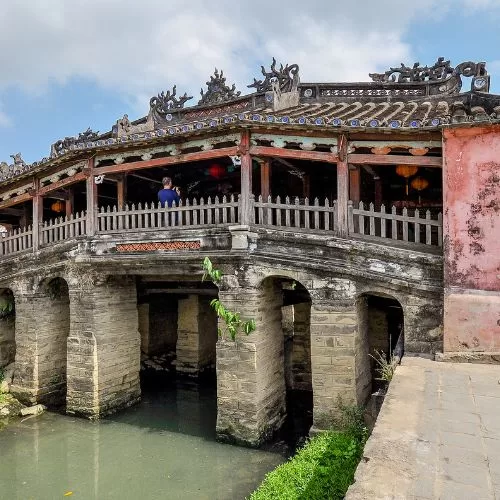
One of the most iconic landmarks in Hoi An is no doubt the Japanese Covered Bridge along the river running through the Ancient Town. This structure dating back to the 16th century has been incredibly well preserved over the years.
Phuc Kien Assembly Hall
This was originally a pagoda built by the Vietnamese in the 17th century. It was then sold to Hoi An’s Fujian-born community as a meeting place to socialize.
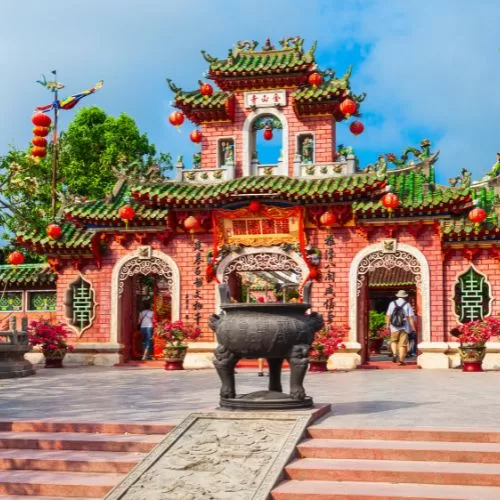
Hoi An Central Market
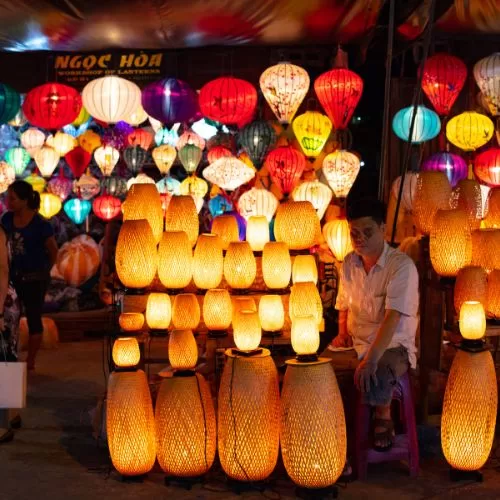
This is an excellent place to purchase some souvenirs while you are in the town. Here you will find a huge mixture of products including silk pieces, lanterns, and other textiles, as well as local food and aromatic spices.
Tran family home and chapel
One of the most popular houses in the Ancient Town is the Old House Of Tan Ky. It belongs to the descendants of a wealthy family of local merchants. It was built back in the 18th century. You will notice a mix of Japanese, Chinese, and traditional Vietnamese architecture throughout the house.
Hoi An Ancient Town
This ancient town is what makes Hoi An so special. It managed to survive the Vietnam War mostly unscathed and is said to have been settled for at least 2000 years. There is an entry fee to the ancient town of 120,000 VND / $5.00 per person.
Cua Dai Beach
Hoi An has also some great beaches easily reachable by bike or motorbike (depending on which part of the city you are staying in). We spent a day on Cua Dai beach closer to the city. The water was clear, sand was soft (and very hot!), coconuts were fresh and palm trees were swaying in the light breeze… It was just a perfect day. To rent a beach bed with an umbrella on Cua Dai, you have to pay 50,000 VND per person (approx. 2.20 USD), which is more than reasonable!
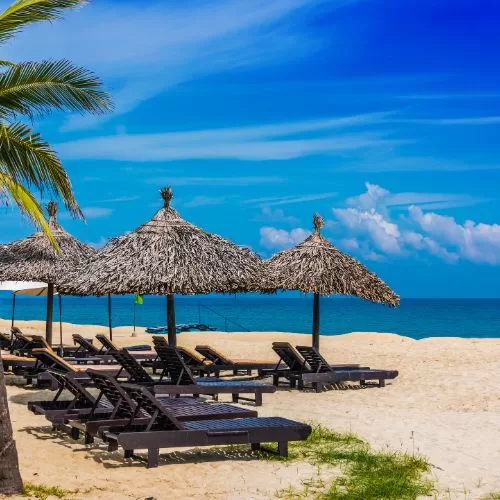
Relaxing On The Beach In Nha Trang – Days 12 to 13

Nha Trang is a popular seaside resort in the south of Vietnam. To get here you need to travel up to Da Nang, and then catch a train to Nha Trang. It’s a 10-hour journey, and it’s best to book yourself onto an overnight sleeper train. We booked all our travel on trains and buses through 12Go. They show you all your travel options to get to your destination. Initially, we weren’t planning on stopping in Nha Trang, however, we decided that a couple of days relaxing on the beach sounded pretty nice.
Nha Trang is known for its offshore islands, dive sites, and beautiful beaches with buzzing streets at night and a tranquil beach atmosphere during the day. Alongside the beach is a pedestrianised beachfront promenade with landscaped gardens, shady benches and drinks stalls. Tall skyscrapers and high-rise hotels overlook the beach and are on a busy main road. Nha Trang is a popular destination with local visitors and has received a great deal of recent development specifically aimed at bringing in more foreign tourists. There are modern shopping malls, fast food chains and lots of western restaurants and markets.
What to do in Nha Trang
Snorkeling Tour
Nha Trang has over 12,00 hectares of marine reserve – So why not go snorkelling in Nha Trang! This coral-filled area is known as Hon Mun Marine Protected Area and is where you will visit. It is the perfect place for both diving and snorkeling as the water is not too deep. Ultimately making it ideal for people of all expertise.
Thap Ba Hot Springs and Mud Baths
If you want to experience smooth skin and immerse yourself in the local hot springs, then you should visit Thap Ba Hot Springs and Mud Baths. Nha Trang is also known for its mud baths and is one of the most popular places for this experience. The mud at Thap Ba Hot Springs and Mud Baths is said to have healing properties thanks to its high mineral content and people usually slather their skin with the mud and then lie down in the bath and let it work its magic.
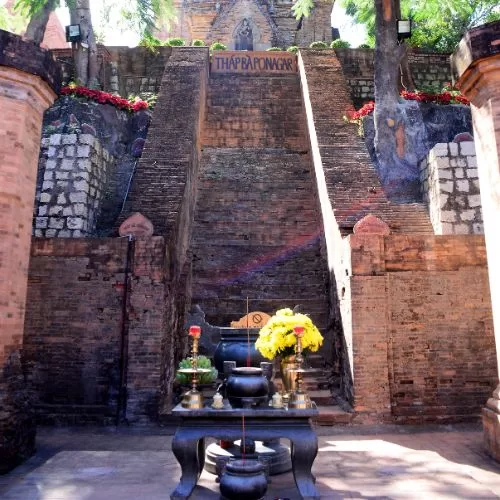
Visit the Buddha
Nha Trang’s main landmark is the large Buddha which sits on one of the hills overlooking the city. Sitting behind the Long Son Pagoda, you can find it on the summit of a hill. The Buddha sits on a pretty lotus blossom and measures an impressive 14 meters in height.
Ho Chi Minh City – The Final Stop – Days 13 to 15

Our last stop in the Vietnam leg of our journey was Ho Chi Minh City. Ho Chi Minh is located in the south and is one of the busiest cities in Vietnam. Formerly known as Saigon, it received its name change to Ho Chi Minh after colonization. It’s a vibrantly modern city thrumming with life – both day and night! Ho Chi Minh has everything you might expect from a large city, from large shopping malls, modern skyscrapers, fast food chains and rooftop cocktail bars. Despite all the relatively new developments in the city, you can still find traces of the traditional Vietnamese way of life within the local markets, street food stalls and small local restaurants and noodle shops tucked down little side roads. Just like in Hanoi, crossing the streets can be quite the experience, although the locals seem to just glide through the traffic like they’re parting the sea.
Again, we travelled by sleeper train, catching the evening train from Nha Trang and reaching Ho Chi Minh 9 hours later. We spent our first day acclimatising ourselves to the hustle and bustle of the city. We spent the day just strolling through the city centre, visiting museums, eating all the street food, checking out the well-preserved architecture and in between all of this, relaxing in the parks. Then, as night fell, we took in the famous Bui Vien walking street – full of pubs, bars, restaurants and street food stalls. Here you will find exotic and authentic offerings … fancy a crispy BBQ scorpion or perhaps a delicious warm bowl of pho? Well, you’ve come to the right place – you can find both here! The walking street starts at 8 pm, during the day it’s open for cars and motorbikes.
Things to do in Ho Chi Minh
Cu Chi Tunnels
There are several tours that you can go on outside of Ho Chi Minh, one of them being the Cu Chi Tunnels. These series of underground tunnels played an important part in the Vietnam War and were an impressive feat of both architecture and engineering. At its peak, there were over 250km worth of tunnels stretching along the countryside, some even leading from Saigon right to the Cambodian border. It is super easy to book a Cu Chi Tunnel tour once in Ho Chi Minh City or in advance online. We booked ours through Get Your Guide.
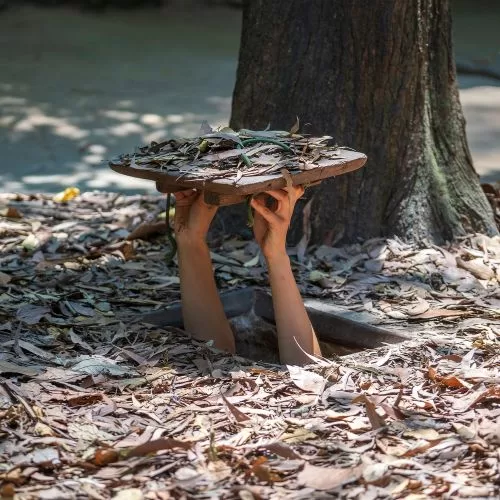
Reunification Palace
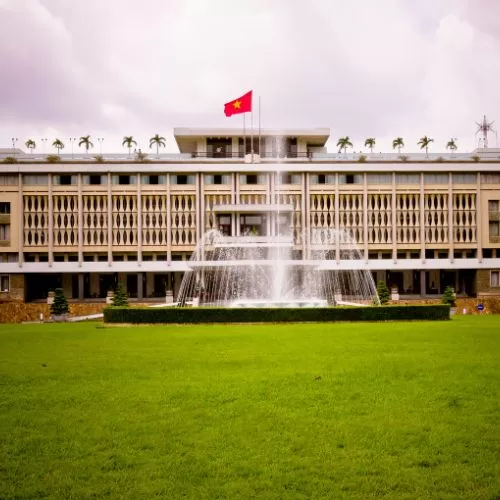
Perhaps one of the most significant places to visit while you are in the city – the former presidential palace for Southern Vietnam, where Saigon fell to the north in what marked the end of the war. You can choose to only see the palace from the outside for free, or if you would like to go inside there is an admission fee of 40,000 VND / $1.50.
Notre Dame Cathedral
Vietnam is packed full of colonial buildings – a remnant from when the French colonised the country. One of these is the Notre Dame Cathedral and it has become a popular attraction in Ho Chi Minh City.

Ben Thanh Market
Touristy or not, no visit to Ho Chi Minh City is complete without checking out Ben Thanh Market. It is the perfect place to pick up those souvenirs for friends and family, try some more local food, and simply watch the locals go about their day.
Bitexco Tower and Skydeck
What better way to experience the city if not from an amazing view? Then Check out the Bitexco Tower – one of the tallest buildings in Vietnam! Head straight to visit the 49th floor where you will find the sky deck with a 360-degree view. The entry fee is 200,000 VND / $7.80, still an incredibly affordable experience. Expect crowds if you head up at sunset, everyone is seeking that Instagram-perfect photo.
Where To Stay In Ho Chi Minh
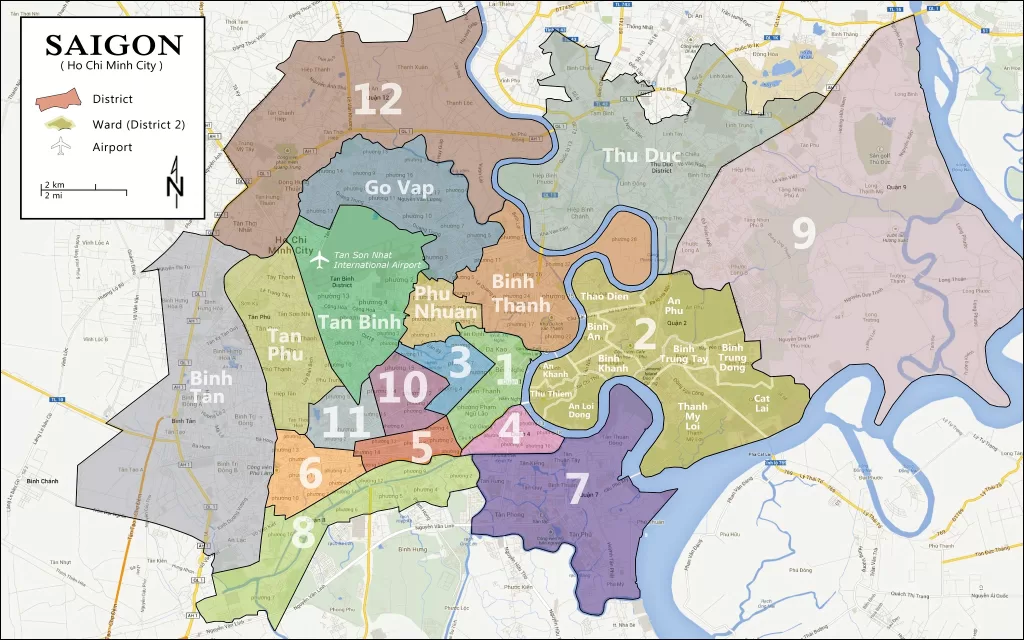
Staying in District 1, Saigon
Ho Chi Minh’s downtown District 1 is where most travellers choose to stay. Its hotels are just a short distance from many of the city’s most important landmarks, major museums, dining, nightlife and the starting point for most tours. You’ll find tree-lined boulevards, charming French architecture, bustling markets, and cuisine from all around the world. With so many places to visit in Ho Chi Minh, this is a great area to base yourself on your first visit.
District 2 & Binh Thanh
A little quieter than District 1, District 2 is rapidly gaining a name as one of the city’s upcoming and stylish neighbourhoods. It’s a more mellow experience compared to the intensity of downtown Ho Chi Minh. The river setting is pleasant as this district sits on the opposite side of the river, it is something of a haven for the arts. The argument for basing yourself in District 2 has strengthened thanks to the fact that it now seriously rivals District 1 as an international culinary centre.
Staying in Cholon, Ho Chi Minh’s Chinatown
District 5 is more commonly known as Cholon and it’s Ho Chi Minh City’s Chinatown. Cholon means “big market” and it’s obvious why as soon as visitors arrive at Binh Tay Market, which is the largest market in the country. Cholon is even more energetic than the city centre. It has its own set of interesting attractions and dining options and an old-world feel that is increasingly disappearing downtown.
For a full Ho Chi Minh Itinerary, check out our post on Top 12 Things to do in Ho Chi Minh.
Important Travel Tips For Vietnam
Visas
First, check to see if your country is exempt from a visa, as some countries do not need to apply for one. However, most travellers will need a visa to enter Vietnam. You can apply for an e-visa online. Tourist visas are generally valid for thirty days from your specified arrival date, and for a single entry, though longer durations can be arranged.
What To Pack
As we say in all our packing list guides, do not overpack. Similar to other Southeast Asian countries, you don’t need to take a lot with you as you will also be able to buy things there. Whatever you do, make sure you bring a few quick-dry clothes, a sturdy rain jacket (look at our recommendations on the best ones), as well as a good pair of hiking boots or trainers.
Avoid Scams
Be aware of local scams that happen in the area you are travelling to. Some of the main scams are taxi scams – the meter is rigged and you get charged more. Instead, book a ride through a ride-share app like Grab. You will get a set price to pay and if you do not feel happy with the driver that shows up, you can always cancel the ride and book another.
Do Not Drink Tap Water
The tap water in Vietnam is generally not potable. It’s best to drink bottled or filtered water instead. Bringing a water bottle with an inbuilt filter is an option – see these if you do not want to be using single-use bottles throughout your trip. Additionally, do not eat fruit and vegetables, or salad from food stalls as these might be washed in tap water. Most importantly, don’t say yes to ice in your drink – again probably made from tap water.
Get A Local SIM Card
Buying a local sim is easy – you can usually get one from the airport on arrival, or you can purchase an E-Sim should your mobile phone allow you to load one. Check out data and call packages, as well as messaging. If you are travelling in a group, you want to be able to communicate should be split up for some reason.
Essential Travel Toolkit
🚖 Rideshare Apps – The most complete guide to Rideshare, Ride-hailing and taxis in Southeast Asia.
🚞 12Go.com – The easiest way to book transport, public or private in Southeast Asia, Japan and Beyond.
🏨 Trip.com – Consistently great accommodation and hotel deals.
🛩️ Trip.com – Get the best flight deals.
🚙 Trip.com – Find your perfect rental car.
🗺️ Getyourguide.com – Looking for an amazing local guide or tour. Get Your Guide will have something for everyone.
🗺️ Viator.com – Easily book tours and experiences at the lowest rate. Amazing options all over the world.
👨💻 NordVPN.com – Reliable VPN service that is guaranteed to keep you and your data safe anywhere in the world.

Wendy is a traveller, writer, and photographer with an insatiable curiosity for the world. Her journey, spanning South Africa, the UK, and now Australia, infuses her work with a rich tapestry of experiences. Join her on Getting Lost Again as she shares her creative perspective and passion for overland travel alongside Dan.

